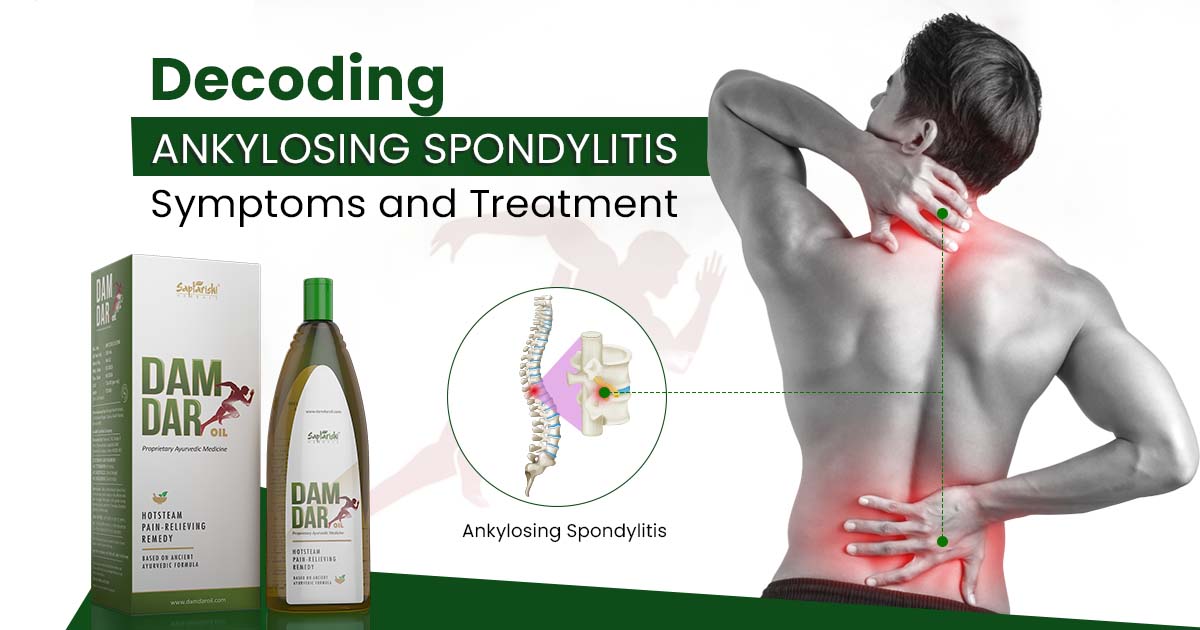Decoding Ankylosing Spondylitis: Symptoms and Treatment

Introduction:
So, you've heard of this thing called ankylosing spondylitis, right? It's a bit of a mouthful, but basically, it's a pain in the back (literally). Medically ankylosing spondylitis (AS) is a long-lasting condition where your spine gets swollen and painful, making it hard to move. Sometimes, the bones in your spine can even grow together, causing more problems. Knowing the signs and treatments is super important to handle AS well.
Let's break it down in simpler terms - what it is, how to spot it, and what you can do about it.
Whatis Ankylosing Spondylitis?
Alright, picture this: you wake up one morning feeling like your back has been hit by a truck. You're stiff as a board, and every move you make sends a jolt of pain down your spine. Ankylosing spondylitis is a type of arthritis that primarily affects the spine, causing inflammation of the vertebrae. Over time, this inflammation can lead to fusion of the spinal bones, resulting in stiffness and loss of mobility. However, AS can also affect other joints, such as the hips, shoulders, and knees. The specific reason why AS happens isn't clear, but experts think it's probably due to a mix of things like your genes and things in your environment.
That's AS, in a nutshell. It's a sneaky little devil that inflames your spine and can eventually turn it into something resembling a tree trunk.
Spotting the Signs: Ankylosing Spondylitis Symptoms
AS isn't exactly shy about making its presence known. Here's a handful of unmistakable signs to keep on your radar:
Back Pain for Days: If your back feels like it's been run over by a bulldozer, especially in the wee hours or after lounging around for a bit, AS might be the culprit.Persistent pain and stiffness in the lower back, may worsen with rest and improve with exercise.
The Morning Struggle: Ever wake up feeling like the Tin Man? That's AS saying "good morning" in its own twisted way.Inflammation can occur at the points where tendons and ligaments connect to bones. This can cause pain and swelling in the heels, knees, and hips.
Neck Nuisance: It's not just about the back - your neck might decide to join the party too. It's common to have difficulty moving the neck, which can be particularly pronounced in the morning or after periods of inactivity.
Fatigue: Feeling exhausted, often due to the chronic inflammation associated with AS.
Diagnosing ankylosing spondylitis can be challenging, as its symptoms often overlap with those of other conditions. A thorough medical history, physical examination, and ankylosing spondylitis radiology such as X-rays or MRI scans are typically used to confirm a diagnosis. Blood tests may also be performed to check for markers of inflammation, although these are not specific to AS.
What Can You Do About It: Spondylitis Treatment
Don't worry, it's not all doom and gloom. There are ways to show AS who's boss:
Ankylosing Spondylitis Medications: Your doctor might prescribe some meds to help tame the inflammation and ease the pain. Think of them as your trusty sidekicks in the battle against AS.Nonsteroidal anti-inflammatory drugs for ankylosing spondylitis (NSAIDs) such as ibuprofen or naproxen can help reduce pain and inflammation in the joints. In more severe cases, disease-modifying antirheumatic drugs (DMARDs) or biological therapies may be prescribed to suppress the immune system and prevent further joint damage.
Physical Therapy: Regular exercise and physical therapy can help improve flexibility, strength, and posture, making it easier to manage symptoms and maintain mobility.
Keep Moving: Yeah, it might hurt like heck, but regular exercise can actually help loosen things up and keep your joints from seizing up like rusty gears.
Heat and Ice: Sometimes all you need is a little hot or cold therapy to take the edge off. Who knew a heat pack could be your new best friend?
Posture Perfect: Slouching? Using supportive devices such as special spondylitis pillows or orthotic inserts can help improve posture and reduce strain on the spine.
Ayurvedic Medicines:
Various herbal remedies and therapies are believed to help manage symptoms of ankylosing spondylitis (AS). Some commonly used herbs in Ayurveda for AS include:
Ashwagandha (Withaniasomnifera): Known for its anti-inflammatory properties, ashwagandha may help reduce pain and inflammation associated with AS.
Guggul (Commiphora mukul): Guggul resin has been traditionally used in Ayurveda to reduce inflammation and pain in joints, which could be beneficial for AS.
Boswellia (Boswellia serrata): Also known as Indian frankincense, boswellia contains compounds that have been shown to have anti-inflammatory effects, which could be beneficial for managing AS symptoms.
Living Your Best Life
Ankylosing spondylitis is a long-term condition that leads to inflammation primarily in the spine, resulting in pain, stiffness, and limited movement. Early diagnosis and appropriate treatment are essential for managing symptoms and slowing disease progression.
Living with ankylosing spondylitis can be challenging, but with proper treatment with medicine for ankylosing spondylitis and self-care, many people can lead active and fulfilling lives. It is important to work closely with healthcare providers to develop a personalized treatment plan that addresses your specific needs and goals.
Conclusion
By staying informed and proactive, individuals with AS can better manage their condition and improve their quality of life.
Sure, AS might throw a wrench in your plans from time to time, but it doesn't have to rule your life. With the right mindset and a few tricks up your sleeve, you can still manage - even if your back protests every step of the way.Remember, you're not alone in this journey.
